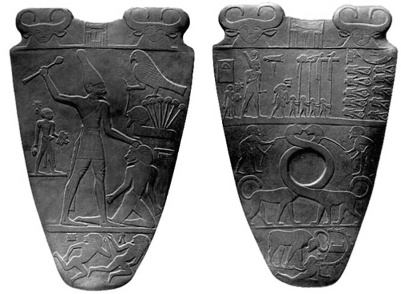The idea that resonated most strongly with me in last week's discussion was the notion of state control over bodies and how this factors into life and into death. On that note, it was especially thought-provoking to have read Foucault's work on biopower in the same week as Bahrani's article "The King's Head" and Richardson's "Death and Dismemberment in Mesopotamia" coupled with a focus on the royal tombs at Ur. It became clear that state powers use bodies in many different ways, as objects to be controlled, subjugated, and surveilled, and throughout history rulers have found numerous ways to maintain control over bodies.
Foucault's discussion on biopower and this elusive concept of the milieu (or realms of everyday living) along with our discussion on the panopticon and its various incarnations (such as the Eastern State Penitentiary) presented the state as interested in controlling bodies through various mechanisms of surveillance. Having taken City and the Festival last semester, I was also intrigued by this idea of creating a city that would enable proper surveillance over its inhabitants as a deterrent to crime. Planned cities often have wide avenues and public spaces, yet for a city one must also plan for future expansion and growth of population. The panopticons seemed to solve this problem of viewing by creating an unlimited disciplinary power of the gaze, control through looking, as the authorities could see what the prisoners were doing at all times. Bodies become objects to be controlled, even in the cases where there wasn't any actual surveillance going on (as the fake video cameras in stores), the very idea, the thought of possible surveillance is a powerful deterrent.
Public executions were for a long time (and still are in some parts of the world) another mechanism of bodily control, and this ties in with Bahrani's discussion of the Assyrian palace relief with Teumman's head. The state holds onto its legitimacy by public execution, essentially taking the right of killing into its own hands while removing it from the people. The state therefore has complete control over bodies, it can decide how to punish you, by incarceration, torture, or execution, while this power is out of the hands of the everyday person. By depicting this image of a defeated foe's severed head on his palace wall, Ashurbanipal makes a strong statement, that any enemies of the state can meet this fate and its within the power of the state to do this. Teumann's head becomes an object, it loses any voice and thus the Assyrian state takes control over his body even unto the afterlife.
Seth Richardson's article further exemplified this state control over bodies in life and in death, as I found the description of the treatment of dead bodies of the enemies a salient example of hegemony over the afterlife. The state has the power to decide if dead bodies can be properly buried or feed to the dogs, and this is the most potent form of bodily control. As the defeated king mentions of his dead brother, "he is now more dead than he was before," by taking away their right to be buried its almost denying a part of their humanity, their bodily existence. Dead bodies are displayed as objects, trophies of war, often piled in giant mounds outside the cities. In Egypt it was quite common to take body parts of defeated enemies to count how many were killed, further evidence of state sponsored body objectification.
The royal tombs at Ur further exemplified how much control a state can have over its subjects, even being allowed to determine when someone lives or dies. There is the assumption that these people went willing to their deaths for the king, possibly as members of the royal court for his afterlife. This continuation of state control into the afterlife has parallels also in ancient Egypt, where at Abydos there are Early Dynastic kings buried with subsidiary graves of sometimes seventy individuals, and in the Old Kingdom there is a notion that being buried next to the king's pyramid means that you will be favored by him in the afterlife. The king is the living embodiement of the god, and if the belief is that the afterlife is eternal, then sacrificing your body in this life for the king may mean a better, longer life after death. The body here is further objectified, becoming a tool for the benefit of the state while something more ephemeral is given precedence.
Whether through surveillance, public executions, or the possibility of control over life and death, states have created numerous ways to turn their inhabitants into disembodied objects. Foucault's idea of biopower plays heavily into the concept of a panopticon, which achieves complete control over its inmates by subjugating them to constant surveillance. Public executions became a spectacle of state power and emphasized the "right" of the state to determine whether someone lives or dies, and the legitimacy of their power is brought to light by these events. The state's power of bodies can potentially extend into the afterlife, and by denying someone proper burial this further disembodies them and could continue after death. Examples from Egypt and at Ur reveal that the state could become so powerful that a body would be sacrificied willingly for association with a king. Mechanisms of state control such as these continue to objectify bodies everyday and have been successful at doing this throughout history, by means of surveillance, public executions, and control over life and death.
 The Narmer Palette, complete with bodies of dead enemies and smiting scene
The Narmer Palette, complete with bodies of dead enemies and smiting scene
